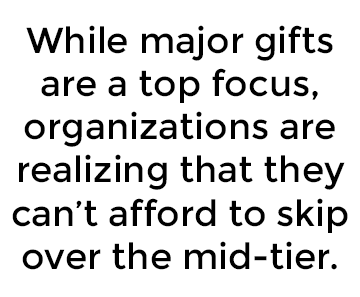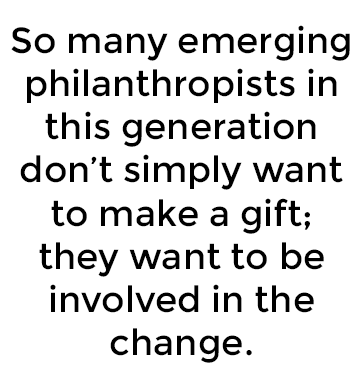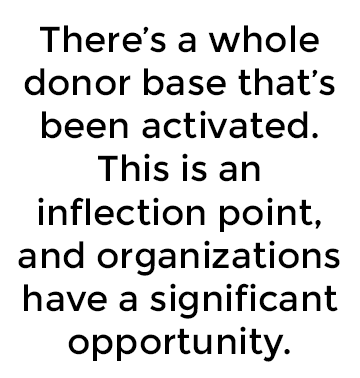

Each year, the Campbell & Company East team counsels nonprofits across the Northeast, East Coast, and beyond. We caught up with them to see what fundraising trends are most prominent in their geographical area, how organizations are adapting, and what regional leaders should expect in 2018.
From data analytics to activated donors, Jeff, Christina, and Elise shared their predictions and on-the-ground insights in the interview below.
Your work gives you a unique mix of national and local perspective. What are your nonprofit partners most focused on going into 2018?

So many nonprofits are aware of these tools but are still figuring out how to fully incorporate them into their daily work.
Elise Krikau: I’m also seeing a big emphasis on building out individual giving programs in general. As Tina mentioned, technology is a game changer in many ways. Still, it can’t replace the value of relationship building: picking up the phone, getting out the door to meet donors, making those meaningful connections with your top supporters.
Organizations are recognizing that they need to get in front of these people more often. At the same time, it’s difficult to find trained and seasoned major gift officers, so that’s a major pain point.
Jeff Wilklow: Concentrating on training and continuous learning can help solve this issue. Good development shops can develop effective major gift officers from within their existing ranks with proper coaching and team building.
Elise: While major gifts are a top focus, organizations are realizing that they can’t afford to skip over the mid-tier.
Jeff: I’ve certainly observed a trend of more middle donor programs. Development leaders are recognizing that—if stewarded appropriately—this class of donors is a key pipeline for major gifts. For this reason, many institutions are investing more resources in building their annual giving programs.
So much is happening on the national stage—from social to economic trends. What developments do you expect to impact philanthropy in the next year?

There was the big bump following the 2016 presidential election, and I think it will persist. It still matters to people, and it’s going to continue to matter under this administration.
Christina: Another important development concern is millennial giving. So many emerging philanthropists in this generation don’t simply want to make a gift; they want to be involved in the change. This is spurring more and more corporations to create programs that give back to their communities and provide employees with volunteering opportunities.
It’s also motivating corporations to integrate philanthropic efforts into their core business and be more strategic about volunteer service.
Jeff: I would argue this shift has been happening for 20 years, but millennials—and the social consciousness that characterizes their generation—have dramatically accelerated the process. As a result, nonprofits have the opportunity to cultivate more corporate support.
Elise: To access that support and solicit a gift, organizations need to provide corporations with a full menu of services. Every company wants to offer volunteering options to their employees—they don’t just want a transactional relationship.
What are the top legislative and political pushes that fundraisers should keep an eye on in the coming months?
Christina: When President Trump was elected, nonprofit leaders worried about how his administration’s agenda would impact their organizations, and many of these changes are now in process.
In the environment and conservation sector, our clients are focusing on all the EPA rollbacks and regulatory repeals that could affect their work. Healthcare organizations are still waiting to see what happens with the Affordable Care Act, the individual mandate, and access to reproductive care.
Elise: Across the sector, all organizations are carefully watching tax reform efforts. This is top of mind for nonprofit leaders, and it has the potential to influence donors’ incentive to give in a major way.
Jeff: In particular, altering or repealing the estate tax could have a significant impact on the wealthiest donors’ estate planning, and this could affect the planned giving landscape.
What is the 2018 philanthropic outlook for your region?

Elise: I agree. Since the Great Recession, we’ve experienced modest but steady increases in giving. I don’t see that changing in our current political environment. Now more than ever, giving back is top of mind, especially to benefit marginalized populations.
Jeff: There’s a whole donor base that’s been activated. This is an inflection point, and organizations have a significant opportunity to build relationships with younger donors, newer donors, and people who haven’t been as mobilized in the past.
Christina: Those newly activated donors are also more discerning and demanding in their approach to giving. At the same time, development officers and organizations are becoming smarter about who they reach out to and how. Overall, it’s an exciting time for the world of philanthropy.
Do you have additional questions for our East team? Leave them in the comments below!